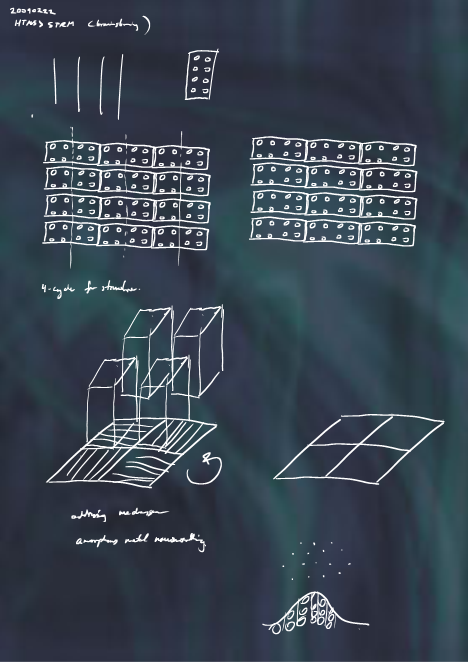Micro-Lego
 The premise of this micro-lego proposal is that mould with amorphous
metallic glass will allow us for the first time make a lego-like part
at the micro-scale with the kind of precision necessary for good
mechanical behavior. Two components are necessary
The premise of this micro-lego proposal is that mould with amorphous
metallic glass will allow us for the first time make a lego-like part
at the micro-scale with the kind of precision necessary for good
mechanical behavior. Two components are necessary
- Part Casting
- Part Assembly
I will address each of these with regard to the assigned
questions about implementation.
Part Casting
what process(es) will it use?
Molding and Casting
It is imperative that the mold be very precise and very smooth. The ideal
candidate would seem to be an amorphous metallic glass (BMG) with a high melting
temperature which could be used to cast parts in a BMG with lower
melting temperature.
Further investigation is necessary to determine what process by which to
create a BMG mold with the necessary precision. If silicon is not too grainy
for the job, immersion lithography could be used for the first step. Otherwise
it may be necessary to use other known techniques for shaping BMG's.
what will (and won't) it be able to do?
Once molds have been fabricated, it should be possible to create many
micro-legos very quickly.
what are the benefits (and disadvantages) over current practice?
Amorphous metallic glass molding is a new technique that allows us to
cast parts with the precision necessary to achieve familiar macro-lego
mechanical behavior. Because of the high ratio of part size to necessary
precision, other techniques which are grainy or less precise can't achieve
good results.
what are the system components?
BMG Vitrification
This is the component I have the least understanding of at this point,
and also one of the most critical. The 2009 paper from Kumar et al
suggests that this process can be done at low cost.
Mold Creation
Casting
which parts exist, and which will require development?
It looks as if the example molds with nm-scale features were created
by processes involving stochastic elements. It was demonstrated that
such features, once existing as a mold, could be faithfully reproduced
by nanomoulding. There may be a void here as far as creating a
fully-custom mold. Possible techniques could be
- Two-Photon Stereolithography coupled with power-of-2 casting duplication
- Immersion Lithography
A question that will initially be open is what ratios to use for block
proportions, and what possible modifications to the latching mechanism
could be advantageous.
what will the workflow be from design to output?
A CAD model of a lego brick will first be
fed into a lithography machine. Some initial one-brickor many-brick
mold will then be iteratively duplicated to create a mold millions of
bricks.
how much will it cost?
If immersion lithography is used, cost will be comparable to that of
producing a next-generation 35 nm chip. Producing blocks will use a
process which is low-cost according to the Kumar et al 2009 paper.
how fast will it be?
BMG may have to be cooled very slowly - but the more you cast at once,
the faster it will be.
what consumables will it need?
Glass and platinum, gold, and/or zirconium. Other materials may suffice
instead, further investigation necessary.
Part Assembly
what process(es) will it use?
- Actuated Platform
- TFT to grasp parts with electrostatic polarization
what will (and won't) it be able to do?
The micro-lego assembler should function similarly to a 3-d printer,
creating arbitrary objects with micron-scale precision.
what are the benefits (and disadvantages) over current practice?
Since the assembly process is entirely mechanical, thermodynamic
processes don't limit throughput.
Objects assembled with this process way could have advantageous
mechanical and electrical properties
Recyclability - objects constructed this way can be deconstructed and
the parts reused.
Mechanical properties can be customized by tuning dimension interleaving.
what are the system components?
- Brick Queuing Channels
- Actuated Platform
- TFT
which parts exist, and which will require development?
The use of TFT to generate electrostatic forces may be a new technique,
and require development. The actuated platform requires precision
mechanical motion, but this should be straightforward with existing
techniques.
what will the workflow be from design to output?
A geometry file is processed using a slicing algorithm. Customizing
mechanical properties by adjusting density of linkages across shear planes
requires additional elements to geometry format.
how much will it cost?
None of the parts in the fabrication machine are expensive. Should be
low-cost.
how fast will it be?
Initially, assembly will be limited by micromechanical and electrical
issues - by electrostatically polarizing small parts, they may fly around
in unexpected ways, and electrostatic and mechanical means to suppress
these effects may limit speed. The are no other theoretical limits. To
convince oneself of the limiting case, picture lining up all layers without
snapping, and then assembling in infinitessimal time by a one-fell-swoop
smash.
what consumables will it need?
The machine will require servo motors, several TFT sheets, IC's, memory,
etc. (or RALA) for processing input data. Mechanical casing material
should not deform with heat or humidity: resin, metal. Machine could
consist largely of Micro-Legos for self-replication. Air filter.
 The premise of this micro-lego proposal is that mould with amorphous
metallic glass will allow us for the first time make a lego-like part
at the micro-scale with the kind of precision necessary for good
mechanical behavior. Two components are necessary
The premise of this micro-lego proposal is that mould with amorphous
metallic glass will allow us for the first time make a lego-like part
at the micro-scale with the kind of precision necessary for good
mechanical behavior. Two components are necessary